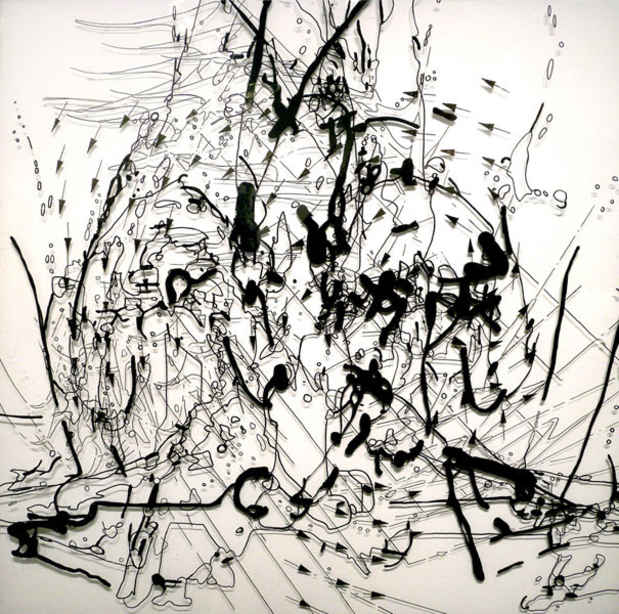"Mapping the Equivocal" Exhibition
Robert Henry Contemporary

This event has ended.
A map is a representation of space or place, or of phenomena as they exist in space. They project a three-dimensional space on a 2-D plane, usually much smaller than the actual space being mapped. The best maps are often considered to be the most accurate ones, however, the assumptions, intentions, biases and preferences of the mapmaker subjectify every map. Maps convey nonlinear and simultaneous knowledge. In a single glance a viewer can tell what’s going on over the whole map at a single moment in time, a Gestalt. The three artists in this exhibition use what could be considered “thematic maps” to explore ideas related to hermeneutics, biology, environmental degradation and ontology.
Phillip Buntin's enamel on Plexiglas aggregation of symbols taken from various biological and scientific sources are layered to the point of confusion as he analyzes what it means to understand and mis-understand at the same time. “I am interested in how we come to terms with complexity and how complex phenomena always, on some level, elude our grasp.” This work explores the experiential aspects of incompleteness that is embedded within fullness. He is particularly interested in the degree to which absence can be expressed through presence, the relationship between the two, and how they might be intertwined.
Derek Lerner's obsessive mark making builds dual perspectives organically as he expresses his attempt to reconcile conflicting feelings about human impact on our environment, including his own. Looking both biological and man-made, micro and macro, his lyrical compositions embody dualities, "…while in many ways my work is a reaction to over-consumption and environmental politics, the drawings themselves are yet another "thing" added to the world, made no less with materials that are potentially damaging to the environment." Although Lerner's work emphasizes the destructive nature of man, his work is evidence that beauty can be found in what humans make as well as what we destroy; and that it is perhaps unavoidable for humans to create without consuming at the same time.
Robert Walden uses thousands of meticulous lines to plot minimal aerial views or maps of fictional cities, each with elaborate urban zones complete with housing developments, industrial areas, and business districts that feel both foreign and familiar, and serve as metaphors for time and the nature of being. Each drawing is a depiction of both the time it took the artist to make the drawing and the time depicted in the fictional location being represented. His work analyzes concepts about essence, substance, time, location, space, and identity by building upon physical, temporal, and literal metaphors that are often used to convey ideas about a process as well as a product.
Mapping the Equivocal explores the notion of what constitutes a map, the interpretation of meaning and the concepts that compel each of these artist to incorporate mapping as a metaphorical tool. A complex weaving of diverse political, cultural, social and philosophical ideas chart a rich and intriguing course and offer viewers opportunities to explore the American landscape from three distinct points of view.
Media
Schedule
from July 13, 2012 to August 12, 2012
Opening Reception on 2012-07-13 from 18:00 to 21:00